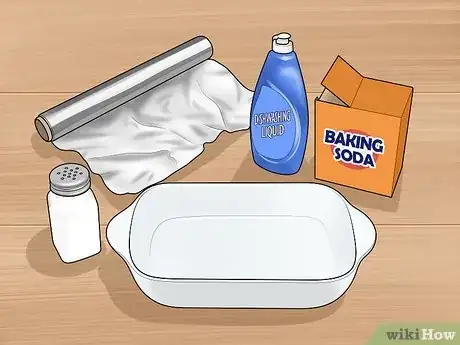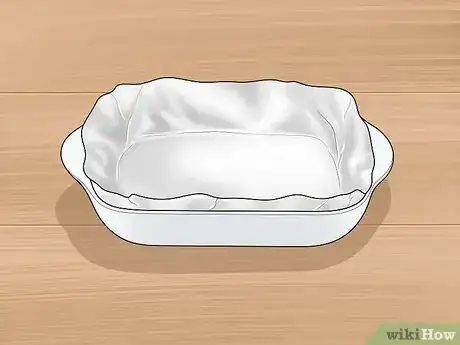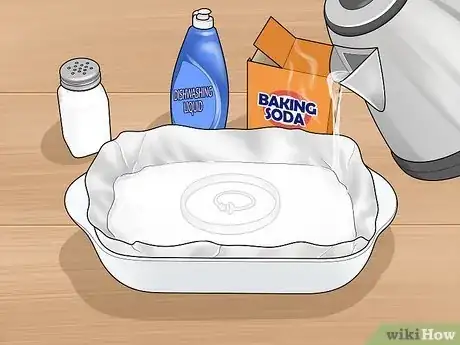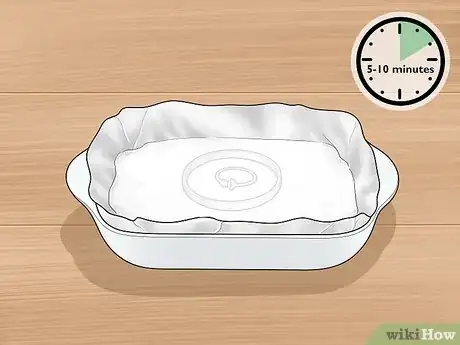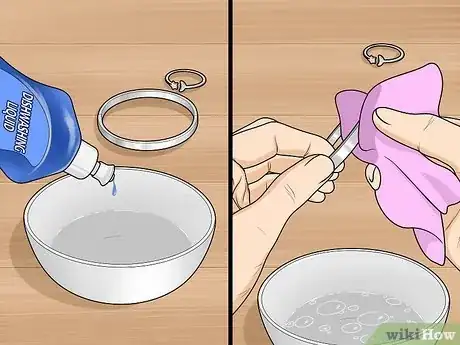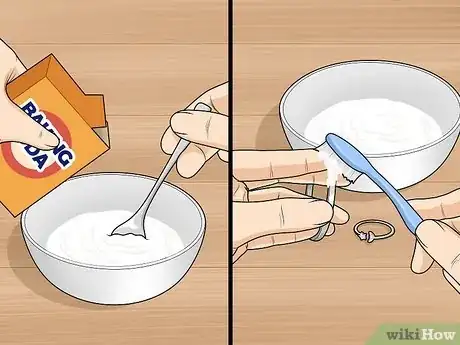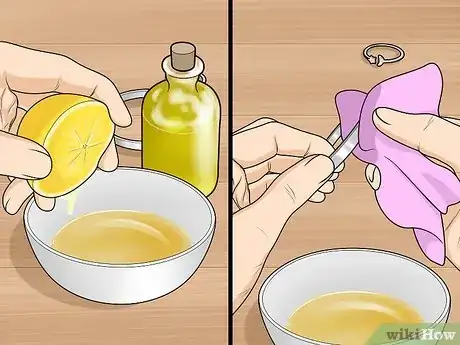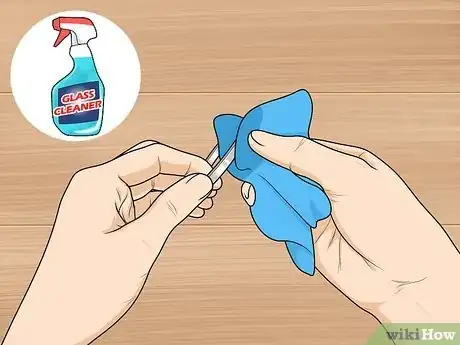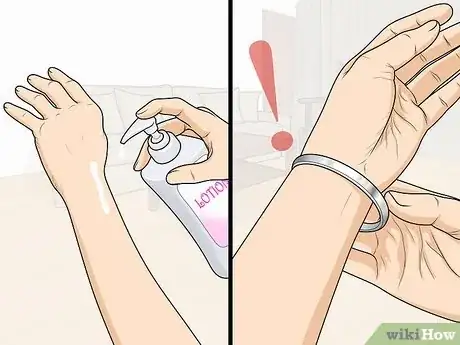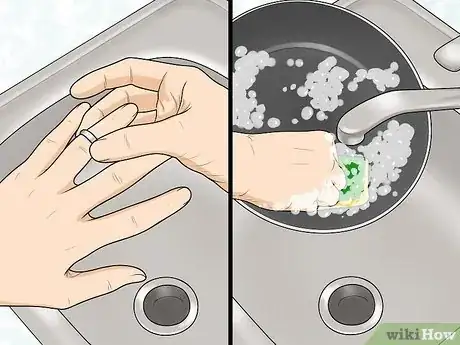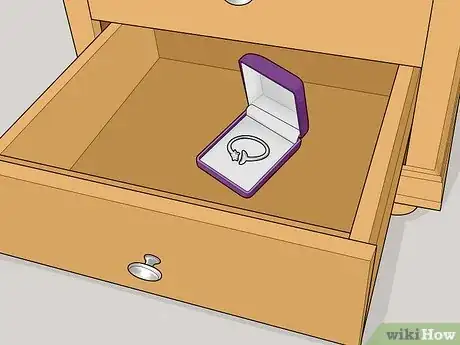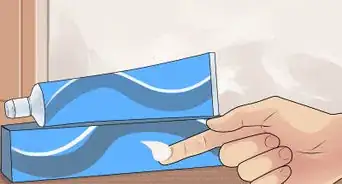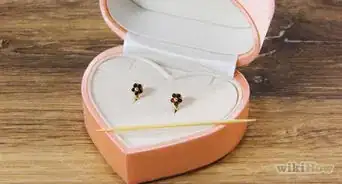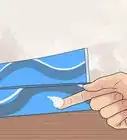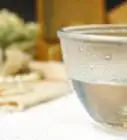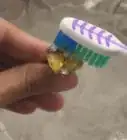This article was co-authored by Jerry Ehrenwald. Jerry Ehrenwald, GG, ASA, is a graduate gemologist in New York City. He is the previous President of the International Gemological Institute and the inventor of U.S.-patented Laserscribe℠, a means of laser inscribing onto a diamond a unique indicia, such as a DIN (Diamond Identification Number). He is a senior member of the American Society of Appraisers (ASA) and is a member of the Twenty-Four Karat Club of the City of New York, a social club limited to 200 of the most accomplished individuals in the jewelry business.
There are 7 references cited in this article, which can be found at the bottom of the page.
This article has been viewed 307,017 times.
Sterling silver isn’t pure (pure silver is known as fine silver) but rather an alloy that contains about 10 percent of another metal, such as copper. Silver is actually a very soft metal, so it’s combined with other metals to make it stronger and more functional. Sterling silver is often used for cutlery, serving utensils, jewelry, accessories such as hair clips, and even business tools like letter openers. The silver that’s in sterling silver can tarnish when it comes into contact with certain environmental pollutants, and the alloy metals are often reactive with oxygen, making sterling silver prone to corrosion and tarnishing. But whether you need to clean your favorite watch, your grandmother’s soup ladle, or your fancy cutlery in preparation for a big dinner party, it is possible, and relatively simple, to clean and polish sterling silver objects.
Steps
Cleaning With the Electrolyte Method
-
1Gather your supplies. The electrolyte method for cleaning silver uses a basic chemical reaction with baking soda, salt, water, and aluminum foil to clean and polish sterling silver. This method isn’t suitable for silver pieces that have porous stones or gems, such as pearls, shells, or turquoise, or for antiques (such as candlesticks) or jewelry that are affixed with glue.[1] For this method, you will need:[2]
- 2 tablespoons (30 g) each of salt and baking soda
- 2 tablespoons (30 ml) liquid dish soap (optional)
- 2 cups (480 ml) boiling water
- A baking dish (or bowl) large enough to fit the pieces you wish to clean
- Aluminum foil to line the baking dish
- The silver pieces you want to clean.
-
2Prepare the baking dish. Line the dish with the aluminum foil. Make sure the shiny side of the foil is facing up.[3] Then place your sterling silverware into the baking dish.Advertisement
-
3Add the cleaning agents. Pour the salt, baking soda, and dish soap over top of the silver pieces, and then pour the boiling water on top. Stir the solution to help dissolve the salt and baking soda.
- Make sure all the silver pieces are touching the foil, as the tarnish from the silver will transfer to the foil.
-
4
-
5Rinse and buff the silverware. Remove the silver from the solution and rinse it under warm water. Gently buff the pieces with a soft cloth to dry and polish the silver.
- Because silver is so soft, it can scratch easily. Be sure to use a soft and non-abrasive cloth to polish, such as microfiber or lint-free flannel.[6]
- Always polish and buff silver in the direction of the metal’s grain, and never in a circular motion.
Removing Tarnish From Delicate Silver
-
1Use soap and water. For jewelry decorated with porous gems, watches, antiques that have pieces held with glue, or other delicate silver pieces that can’t be immersed in water or cleaned with the electrolysis method, there are still several options for cleaning.
- Mix one tablespoon (15 ml) dishwashing soap (something that’s phosphate-free and ammonia-free) with one cup (240 ml) warm water and stir well. If you want, use a hand blender to mix up some suds.
- Dip a soft cloth into the soapy water and wring out the excess. Use the damp cloth to clean the silver. Rinse out the cloth with plain water, and wipe off any leftover soap residue. Use a fresh cloth to buff and dry the silver.
EXPERT TIPJerry Ehrenwald, GG, ASA, is a graduate gemologist in New York City. He is the previous President of the International Gemological Institute and the inventor of U.S.-patented Laserscribe℠, a means of laser inscribing onto a diamond a unique indicia, such as a DIN (Diamond Identification Number). He is a senior member of the American Society of Appraisers (ASA) and is a member of the Twenty-Four Karat Club of the City of New York, a social club limited to 200 of the most accomplished individuals in the jewelry business.Former President, International Gemological Institute & Graduate Gemologist
 Jerry Ehrenwald
Jerry Ehrenwald
Former President, International Gemological Institute & Graduate GemologistStart with soap and water before using other methods. Choose a mild, ammonia- and phosphate-free dish soap. Fill a bowl with the soap and warm water, dip a toothbrush into the bowl and gently scrub the jewelry. Rinse the piece in a separate bowl of warm water and dry it off with a towel.
-
2Make a baking soda paste. Take a tablespoon (15 g) of baking soda and mix it with just enough water to make a paste. With a soft-bristled toothbrush or cloth, clean the silver with the paste, making sure to get into the nooks and crannies with the bristles.
- When the silver is clean, rinse it under warm water or remove the excess paste with a damp cloth. Buff it dry with a clean cloth.[7]
-
3Use lemon juice and olive oil. In a small bowl, whisk together 1 teaspoon (6 ml) lemon juice and 1.5 cups (327 ml) olive oil. Dip a cloth into the mixture, wring out the excess, and use this to polish your silver.
- For small pieces that can be immersed, soak them in the oil and lemon solution and place the bowl into a small saucepan. Fill the saucepan with enough water to bring the bowl off the bottom and turn the heat to medium. Bring up the water temperature and keep it hot, but not boiling, for 15 to 20 minutes.
- Remove the pot from the heat and take the silver out of the oil and lemon juice solution. Gently scrub the silver with a soft toothbrush.
- For either the hot bath or the polishing method, rinse the silver with hot water to remove excess solution, and dry it with a soft cloth.[8]
-
4Give glass cleaner a try. Glass cleaners like Windex can also be used to clean silver. Spray some glass cleaner directly onto a soft cloth or soft-bristled toothbrush.[9] Use the cloth to clean the silver, and then either rinse the piece under warm water or wipe off the excess cleaner with a damp cloth.
- Dry and buff the silver with a soft cloth.
Preventing Tarnish
-
1Keep the silver away from substances that will cause tarnish. Anything that contains sulfur will cause silver to tarnish. To prevent this from happening, keep your silver away from things like:[10]
- Sweat
- Rubber and latex
- Food items like mayonnaise, mustard, eggs, and onions
- Wool
- Lotions, creams, and beauty products
-
2Take your jewelry off. Since there are so many things that can tarnish silver, it’s a good idea to remove your jewelry when you go swimming in chlorinated water or do household chores (to keep the silver away from the chemicals).
- Sunlight can also have an effect, so take your jewelry off any time you plan on spending time in the sun.[11]
-
3Store your silver somewhere cool, dark, and dry. Moisture can cause silver to tarnish, so store your silver somewhere that isn’t too hot or too damp. You can also keep camphor,[12] silica gel packs, chalk, or activated charcoal to the storage area to help remove some of the moisture.[13]
- Store silver away from direct and indirect sunlight to prevent the sun from causing it to tarnish.
-
4Wrap it up. To store silver, seal individual pieces in sealable plastic bags. Push out as much of the air as you can before closing the seal. This will prevent the other metals in the sterling silver from oxidizing.[14]
Expert Q&A
Did you know you can get expert answers for this article?
Unlock expert answers by supporting wikiHow
-
QuestionHow do you clean tarnished sterling silver with gemstones?
 Jerry EhrenwaldJerry Ehrenwald, GG, ASA, is a graduate gemologist in New York City. He is the previous President of the International Gemological Institute and the inventor of U.S.-patented Laserscribe℠, a means of laser inscribing onto a diamond a unique indicia, such as a DIN (Diamond Identification Number). He is a senior member of the American Society of Appraisers (ASA) and is a member of the Twenty-Four Karat Club of the City of New York, a social club limited to 200 of the most accomplished individuals in the jewelry business.
Jerry EhrenwaldJerry Ehrenwald, GG, ASA, is a graduate gemologist in New York City. He is the previous President of the International Gemological Institute and the inventor of U.S.-patented Laserscribe℠, a means of laser inscribing onto a diamond a unique indicia, such as a DIN (Diamond Identification Number). He is a senior member of the American Society of Appraisers (ASA) and is a member of the Twenty-Four Karat Club of the City of New York, a social club limited to 200 of the most accomplished individuals in the jewelry business.
Former President, International Gemological Institute & Graduate Gemologist Former President, International Gemological Institute & Graduate GemologistExpert AnswerStart by using a mild, ammonia- and phosphate-free dish soap and warm water to clean your jewelry before using any other method. First, fill a bowl of warm water and add a little dish soap to mix into the solution. Take a toothbrush and dip it into the soapy water and gently start scrubbing the gemstone and sterling silver. Rinse the jewelry in a separate bowl of warm water and dry it off with a towel or cloth.
Former President, International Gemological Institute & Graduate GemologistExpert AnswerStart by using a mild, ammonia- and phosphate-free dish soap and warm water to clean your jewelry before using any other method. First, fill a bowl of warm water and add a little dish soap to mix into the solution. Take a toothbrush and dip it into the soapy water and gently start scrubbing the gemstone and sterling silver. Rinse the jewelry in a separate bowl of warm water and dry it off with a towel or cloth.
Warnings
- While some recommendations say to clean sterling silver with toothpaste or in the dishwasher, these methods aren’t advised. Both toothpaste and detergent can scratch the metal, and the heat from the dishwasher can make the metal dull.[15]⧼thumbs_response⧽
- Commercial silver polish does exist, but it should be avoided: the fumes are dangerous, the solvents in the polish are detrimental to the environment, and using the polish will remove special coatings, resulting in silver that tarnishes faster.[16]⧼thumbs_response⧽
References
- ↑ http://www.ebay.com/gds/The-Do-s-and-Don-ts-of-Cleaning-Silver-/10000000177627480/g.html
- ↑ http://www.food.com/recipe/jewelry-cleaner-180133
- ↑ https://www.youtube.com/watch?v=8wPLWuy2O7M
- ↑ http://blog.novica.com/how-to-clean-and-care-for-sterling-silver-jewelry/
- ↑ https://www.youtube.com/watch?v=8wPLWuy2O7M
- ↑ http://blog.novica.com/how-to-clean-and-care-for-sterling-silver-jewelry/
- ↑ http://blog.novica.com/how-to-clean-and-care-for-sterling-silver-jewelry/
- ↑ http://www.metaldetectingworld.com/cleaning_coin_p13_ammonia.shtml
- ↑ http://www.radcliffejewelers.com/resource-center/education/jewelry/jewelry-cleaning-guidelines
- ↑ http://blog.novica.com/how-to-clean-and-care-for-sterling-silver-jewelry/
- ↑ http://blog.novica.com/how-to-clean-and-care-for-sterling-silver-jewelry/
- ↑ http://www.ebay.com/gds/The-Do-s-and-Don-ts-of-Cleaning-Silver-/10000000177627480/g.html
- ↑ http://www.ebay.com/gds/How-to-Prevent-Tarnish-on-Sterling-Silver-Jewelry-/10000000009481539/g.html
- ↑ http://www.ebay.com/gds/How-to-Prevent-Tarnish-on-Sterling-Silver-Jewelry-/10000000009481539/g.html
- ↑ http://www.ebay.com/gds/The-Do-s-and-Don-ts-of-Cleaning-Silver-/10000000177627480/g.html
- ↑ http://blog.novica.com/how-to-clean-and-care-for-sterling-silver-jewelry/
About This Article
To clean sterling silver jewelry that doesn't have any gemstones on it, start by placing it in a baking dish that's lined with aluminum foil. Then, pour salt, baking soda, and dish soap over your jewelry. Next, add boiling water to the pan, which will trigger a reaction that will clean your jewelry. Let it sit for 10 minutes and then rinse it off with water. If your sterling silver jewelry does have gemstones, clean it by wiping it down with warm, soapy water. If that's not enough, try rubbing a baking soda paste or lemon juice into the jewelry to clean it. If you want to learn more about how to prevent your jewelry from getting tarnished, keep reading!
